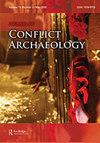Second World War Japanese Defences on Watom Island, Papua New Guinea
IF 0.6
0 ARCHAEOLOGY
引用次数: 6
Abstract
Abstract Watom Island, in the East New Britain Province of Papua New Guinea, was occupied by Japanese forces during the Second World War; twenty-one Allied Prisoners of War (of whom eighteen survived) were held there from 1944 to 1945. Numerous tunnels and defensive emplacements were dug on the island, and many remain open today. During an archaeological research programme at Rakival Village into the prehistoric occupation of Watom, some of these wartime sites were also recorded, and this paper describes a variety of different site types. These include numerous underground tunnel complexes, beach defences, and a 150 mm howitzer that is still in position at the top of the island. It is argued that Watom was more than just an occupied island, and was, in effect, a fort that defended the rear approaches to Rabaul.第二次世界大战日本在巴布亚新几内亚沃通岛的防御工事
第二次世界大战期间,巴布亚新几内亚东新不列颠省的沃通岛被日军占领;从1944年到1945年,有21名盟军战俘(其中18人幸存)被关押在那里。岛上挖了许多隧道和防御工事,其中许多至今仍开放。在Rakival村对史前占领Watom的考古研究项目中,也记录了一些战时遗址,本文描述了各种不同的遗址类型。这些包括许多地下隧道综合体、海滩防御和一门仍在岛上的150毫米榴弹炮。有人认为,沃托姆不仅仅是一个被占领的岛屿,而且实际上是一个防御拉包尔后方的堡垒。
本文章由计算机程序翻译,如有差异,请以英文原文为准。
求助全文
约1分钟内获得全文
求助全文
来源期刊

Journal of Conflict Archaeology
ARCHAEOLOGY-
CiteScore
0.80
自引率
50.00%
发文量
8
期刊介绍:
The Journal of Conflict Archaeology is an English-language journal devoted to the battlefield and military archaeology and other spheres of conflict archaeology, covering all periods with a worldwide scope. Additional spheres of interest will include the archaeology of industrial and popular protest; contested landscapes and monuments; nationalism and colonialism; class conflict; the origins of conflict; forensic applications in war-zones; and human rights cases. Themed issues will carry papers on current research; subject and period overviews; fieldwork and excavation reports-interim and final reports; artifact studies; scientific applications; technique evaluations; conference summaries; and book reviews.
 求助内容:
求助内容: 应助结果提醒方式:
应助结果提醒方式:


